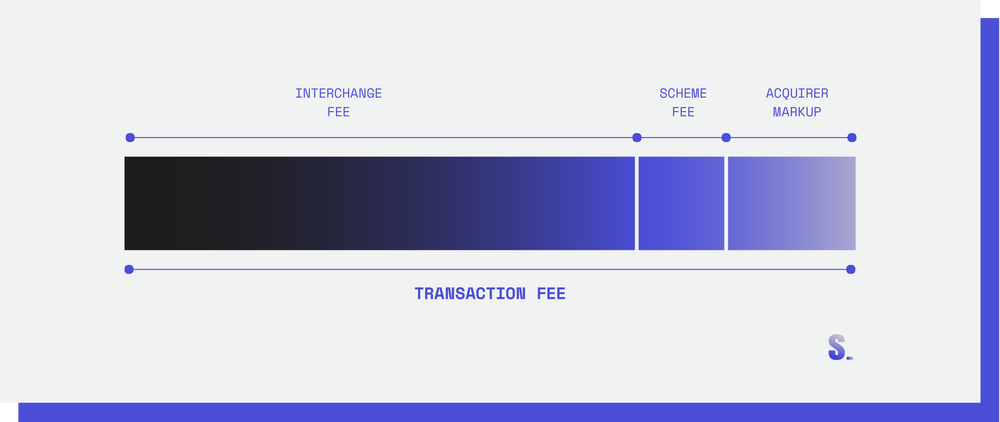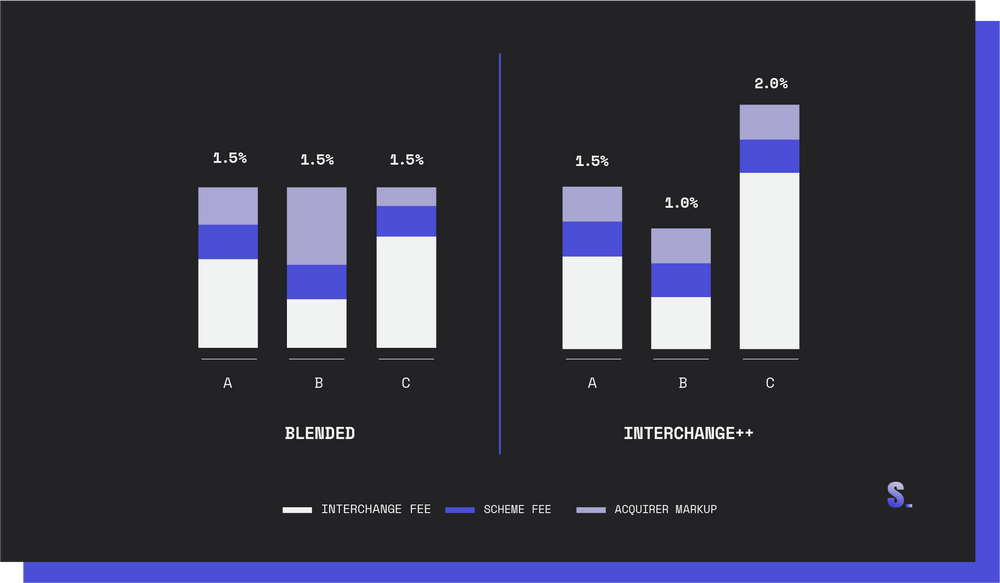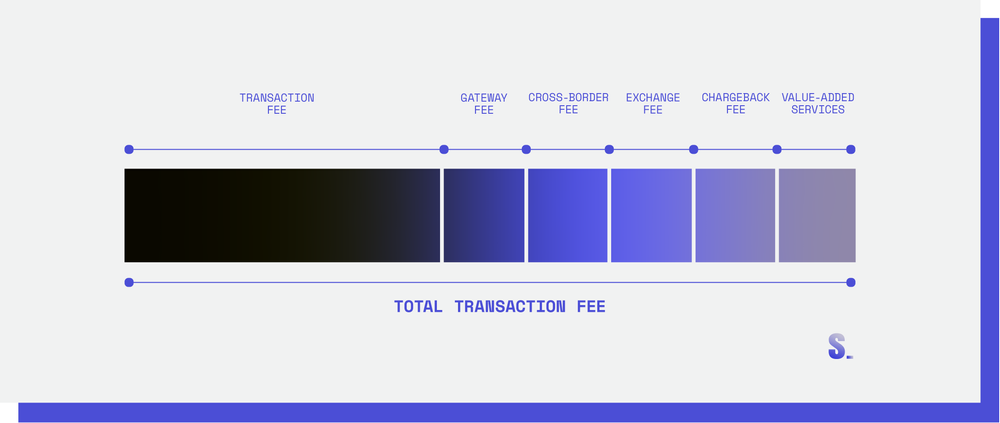Not all payment methods work the same way when it comes to pricing. This article focuses on transaction fees for debit and credit card payments like Visa and Mastercard. If you’re just entering the payment scene, we suggest you take a look into Who’s Who: The Players in the Card Payments Industry.
In the case of card payments that involve the participation of issuers, card schemes, and acquirers, the fee that merchants pay per transaction can be broken down as follows:
- Interchange fee: paid to the customer’s bank, the issuer.
- Scheme fee: paid to the card schemes like Visa or Mastercard.
- Acquirer markup: paid to the merchant’s payment provider—the acquirer or Payment Service Provider (PSP).
Interchange Fees
Interchange fees are paid by the merchant’s bank (the acquirer) to the customer’s bank (the issuer) and account for approximately 70% of the transaction fee.
Interchange fees are a way for issuers to get paid for acquiring new cardholders, growing the network, and protecting transactions against fraud.
Issuers end up with the highest margins per transaction fee because they’re the ones investing to guarantee the customers’ adoption of a particular payment scheme.
Although interchange fees are paid to the issuer, they are assessed and determined by card networks like Visa and Mastercard. Interchange fees vary depending on the region (eg. domestic, interregional), card type (e.g. commercial or consumer), card program (pre-paid, debit, credit), and purchase environment (card-present and card-not-present). The card networks periodically review the interchange fees, which are subject to changes throughout the year.
Scheme Fees
Also known as a network or assessment fee, the card scheme fee is paid by the acquirer to card schemes like Visa, Mastercard, or Amex for accepting and processing debit and credit card payments through their network.
Scheme fees start around 0.01% per transaction and can go up to 1% and above. This variation depends on different factors, including the card network (Visa, Mastercard), card type, merchant and cardholder’s location, currency, and the acquirer’s payment volume. Acquirers with the largest payment volumes have better chances of negotiating scheme fees with card networks.
Acquirer Markup
Suppose that you’re working directly with an acquirer. In that case, the rest of the transaction fee goes to said acquirer for accessing card payments, protecting risks associated with maintaining a merchant account, paying the network fees to the card networks, paying the interchange fees to the issuers, and covering other types of fees like gateway fees, authorization fees, tokenization fees, or fraud screening fees.
If you’re working with a payment service provider like Mollie who partners with acquirers on their side, they will add a margin on top of the acquirer markup in exchange for connections with multiple acquirers and payment methods. PSPs like Adyen that also own acquiring licenses end up absorbing the acquirer markup margin on some card transactions.

The Pricing Models
There are two predominant pricing models for card payments: blended pricing and interchange++.
Blended pricing models are easier for merchants to grasp because the acquirer presents a final fee per transaction without breakdowns. However, this model is not transparent. Merchants can’t see how much they’re being charged on interchange or scheme fees. Because these two fees vary significantly, acquirers have been benefiting from blended pricing by assessing the highest interchange and card network fees for specific use cases and setting a final percentage—including their premium— to avoid operating on negative margins.
Blended pricing models have the advantage of being predictable. If businesses are able to negotiate small rates with their acquirers, they can end up paying less than with interchange++.
Interchange++ pricing models give merchants full transparency over costs. The merchant knows what they’re being charged for in the interchange fee, network fee(+), and acquirer markup(++). This makes it possible for merchants to agree on a fixed percentage for the acquirer markup and save on costs when there are changes in interchange fees.
Interchange++ can be more complex to monitor, but, in the end, it is more transparent and cost-effective than blended pricing.

Other Fees
On top of the regular fees that you must pay to your payment provider for each card transaction, you can be charged other additional fees.
Gateway Fees
While the previous fees pay the different stakeholders for the possibility of accepting card payments, the gateway fee pays for the usage of the technical infrastructure to receive payment information, request authorization from the issuer, communicate the authorization information securely to the merchant, and facilitate payments.
Gateway fees generally correspond to a fixed amount that only varies depending on the merchant’s transaction volume. These can be included in your payment provider price, or they may be presented as a separate fee if you’re working with a payment gateway.
Cross-border Fees
Payment providers might charge additional fees for merchants that want to operate internationally. Cross-border fees are charged for transactions in which the customer uses a card from an issuing bank that is located in a different country from the one of the merchant’s account.
Exchange Fees
Besides the conversion rate applied for currency conversion, your payment provider will charge you an extra fee that typically ranges from 1% to 3% for transactions made in a currency other than yours.
Chargeback Fees
For each chargeback that your business incurs, your acquirer will charge you a chargeback fee. If you maintain a high chargeback rate, you can be penalized with higher fees on all transactions.
For more details on how to reduce your chargeback rate, check out the article Chargebacks: How to Stop Them From Killing Your Business.
Value-Added Services
Any value-added service typically provided by PSPs or gateways can have an impact on transaction costs. These could be payouts, split payments, Merchant of Record (MOR) setups, authentication services (e.g. 3DS), risk services, or analytics tools.

On each transaction, and for each payment method, your payment provider receives a fee that is split differently between the other parties participating in the payment flow. In card payments, this flow might seem more complex. Different pricing models can put businesses in a more or less favorable position regarding cost-effectiveness. The companies that are aware of how transaction fees work are also more prepared to negotiate these fees with their payment providers.
At Switch, we work with different payment providers—acquirers, PSPs, and gateways—for the same payment methods, giving businesses the added flexibility when choosing their payments partner, and the ability to reduce transaction costs. Take a look at our channels to know more about the payment methods we offer and the providers we partner with.
If you want to know how you can start reducing your transaction fees take a look at our article "How to Effectively Reduce Card Payments Fees".
Interested in optimizing your payments operations? Reach out to us.